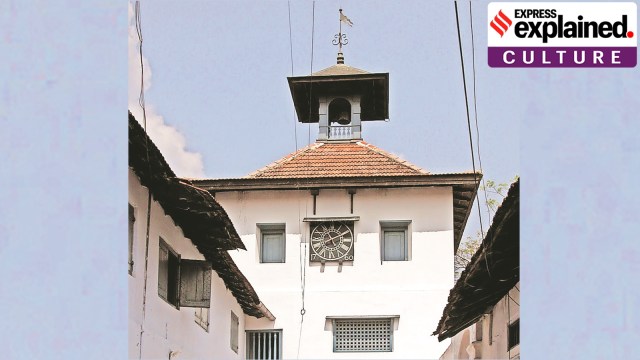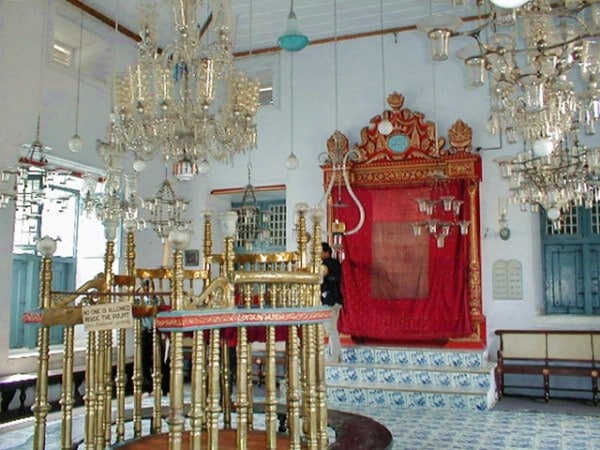Once thriving, now all but gone: a history of Kerala’s Jewish communities
From boasting a population of 20,000-50,000 in the mid-1940s, India’s Jewish population today is estimated to comprise 4,000-5,000 members.
 Clock tower of the Paradesi synagogue in Mattanchery. (Image source: Wikimedia Commons)
Clock tower of the Paradesi synagogue in Mattanchery. (Image source: Wikimedia Commons)Queenie Hallegua, 89, died in Kochi on Sunday (August 11). She was the last woman of Kerala’s once-vibrant Paradesi Jewish community. Her death left her nephew Keith, 65, as the last Paradesi Jew in Kerala.
The Jews of Kerala
From boasting a population of 20,000-50,000 in the mid-1940s, India’s Jewish population today is estimated to comprise 4,000-5,000 members. Almost all belong to the Marathi-speaking Bene Israel community, settled on the Konkan coast for hundreds of years. They are not, however, the oldest Jewish community of India. That honour goes to one of Kerala’s two main Jewish communities.
MALABAR JEWS, also known as the Cochin Jews, trace their history to the days of King Solomon (hypothesised to be in the 10th century BCE, almost 3,000 years ago). Initially, they settled in Cranganore (present-day Kodungallur in Thrissur district), which the community itself referred to as Shingly.
The oldest documentary evidence of this community — a set of copper plates given to the local Jewish leader by the Cranganore’s Hindu ruler, from circa 1,000 CE — lists various economic and ceremonial privileges that the Jews enjoyed in the region. From the 14th century onward, and especially following the arrival of the Portuguese in the 16th century, Malabar Jews moved further south from Cranganore to Cochin (now Kochi) where the local king rolled out the red carpet for them.
PARADESI JEWS, literally “foreign” Jews, migrated to the Indian subcontinent in the 15th and 16th centuries from the Iberian Peninsula. They fled to India due to persecution by the Catholic rulers of Spain and Portugal, and settled on the Malabar coast alongside pre-settled Jewish communities, as well as in Madras (now Chennai). The Paradesi Jews of Cochin were active in Kerala’s spice trade, and those settled in Madras were involved in the trade of Golconda diamonds and other precious stones.
 The 16th century Paradesi Synagogue in Kochi, Kerala. (Via Wikimedia Commons)
The 16th century Paradesi Synagogue in Kochi, Kerala. (Via Wikimedia Commons)
In Kerala, the Paradesi Jews adopted Malyalam, and many local customs and traditions. But at some point, they stopped marrying those from Kerala’s older Jewish community, and began to look down on them. This effectively created two distinct Jewish communities in Kerala. Many accounts, especially by Western writers, refer to the Paradesis as “White Jews” and the Malabaris as “Black Jews”, although this pejorative characterisation is largely inaccurate.
In Cochin, the Koders were among the most prominent Paradesi Jewish families. Samuel Koder (1908-94) ran the Cochin Electric Company which operated from the 1940s till the late 1970s, before the Kerala State Electricity Board (KSEB) bought it. He was one of the tallest Jewish leaders in India, and, according to his obituary in The New York Times, “an authority on the history of the Jews of Kerala”. Samuel’s father, also named Samuel (1869-1941), built the famous Koder House, now a boutique hotel in Kochi. Queenie was Samuel Jr’s daughter.
A dwindling community
Unlike Jewish communities in Europe or West Asia, the ones in India seldom faced anti-Semitism or persecution. Many, like the Koders, rose to high positions as agents of foreign trade, and advisers to Dutch and Hindu rulers. Later, during British rule, Jews in Kerala prospered as merchants and were employed as teachers, clerks, and lawyers in the ever-expanding British bureaucracy.
However, since the 1950s, there has been a steady migration of Kerala Jews to Israel. According to estimates, there are well over 4,000 ‘Cochinim’ in Israel today. Most belong to the Malabar Jewish community, with a few hundred Paradesis. Only 14 Malabar Jews, and one Paradesi Jew are now left in Kerala.
“Jew Streets” in Mattancherry and Kochi, and formerly Jewish-owned shops and business houses, are among the few remaining relics of Kerala’s once-thriving Jewish community. So are the state’s seven synagogues, the most prominent among which is the Paradesi Synagogue built in 1568 CE in Mattancherry, among the oldest synagogues in the Commonwealth. Queenie’s late husband Samuel Hallegua was its last warden.
There are three other Paradesi synagogues at Paravur, Chendamangalam, and Mala. All of them are protected monuments. Malabari Jews have three synagogues, with only the Kavumbhagam Ernakulam Synagoge still active. This too was taken over by the state government in 2021 for conservation.




- 01
- 02
- 03
- 04
- 05


































